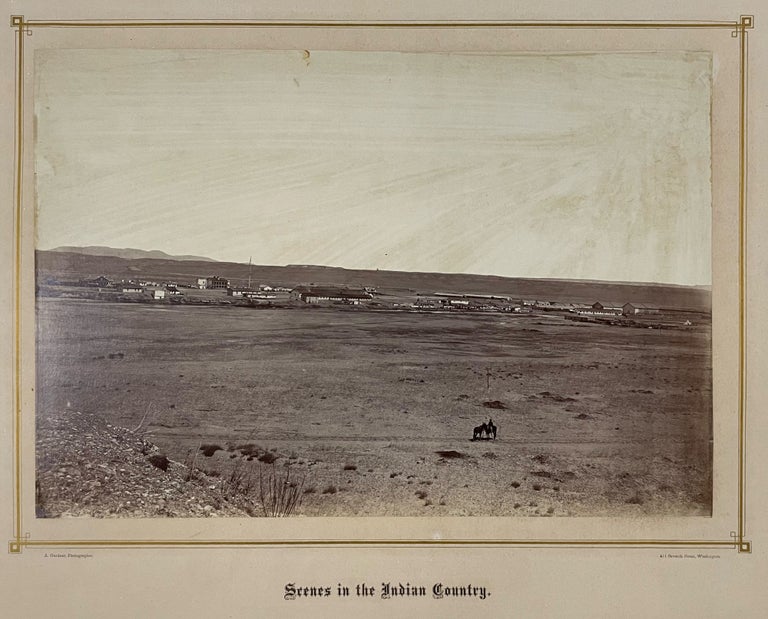GARDNER, Alexander (1821-1882, Photographer)
Scenes in the Indian Country: Fort Laramie
Fort Laramie, Wyoming: A[lexander] Gardner. 511 Seventh Street, Washington DC, 1868. Albumen Silver Photograph. Albumen silver photograph on letter-pressed beige board mount with gilt decorative border joined by print attribution and series title caption, "Fort Laramie" pencilled in lower right margin. Image: (12 3/4 x 18 3/4 inches). Sheet: (19 1/4 x 23 3/4 inches).
An early townscape of Fort Laramie, Wyoming, taken by renown Civil War photographer Alexander Gardner. Fort Laramie was the negotiating site and namesake of two of the most notorious US broken treaties with Native Americans, in 1851 and 1868.
In 1868, Gardner was commissioned by the US Government to photograph the peace talks between the federally-appointed Indian Peace Commission, which included General Sherman, and chiefs of the Plains Indians tribes at Fort Laramie in Wyoming. Gardner's series of photographs, Scenes in the Indian Country, from which this present work comes, includes images of Indian tribal leaders who gathered at Fort Laramie to meet with the Indian Peace Commissioners. The series is considered to be among his most poignant works. In the 1860s, Plains Indians found themselves in the middle of the country with white advancement on both sides. New railway lines were cutting through indigenous hunting grounds, which scattered the game necessary for their survival. In an attempt to end conflict, an unprecedented gathering of tribal leaders from the Northern Plains assembled at Fort Laramie, Wyoming, in 1868. With his wagon serving as a darkroom, Gardner photographed scenes surrounding the treaty negotiations between the US Government's Indian Peace Commission and the tribes who agreed to give up land and move to reservations. Gardner's photographs serve as important documents of the indigenous peoples' presence in the West and their lifestyles, which were rapidly being destroyed by Western expansion and the construction of the Union Pacific Railroad. The US National Archives' description of the Fort Laramie Treaty of 1868: "In this treaty [.] the US recognized the Black Hills as part of the Great Sioux Reservation, set aside for exclusive use by the Sioux people. In the 19th century, the US drive for expansion clashed violently with Native Americans' resolve to preserve their lands, sovereignty, and ways of life. From the 1860s through the 1870s, warfare and skirmishes broke out frequently on the American frontier. In 1865, a congressional committee studied the uprisings and wars in the American West. They produced a "Report on the Condition of the Indian Tribes" in 1867. This led to an act to establish an Indian Peace Commission to end the wars and prevent future conflicts. The US set out to establish a series of treaties with Native tribes that would force American Indians to give up their lands and move further west onto reservations. In the spring of 1868, a conference was held at Fort Laramie, in present-day Wyoming, which resulted in a treaty with the Sioux (Brule, Oglala, Miniconjou, Yanktonai, Hunkpapa, Blackfeet, Cuthead, Two Kettle, Sans Arcs, and Santee) and the Arapaho. The goal of the treaty was to bring peace between White settlers and the tribes, who agreed to relocate to the Black Hills in the Dakota Territory. All the tribes involved gave up many thousands of acres of land that had been promised in earlier treaties, but retained hunting and fishing rights in their older territory. They also agreed not to attack railroads or settlers. In exchange, the US established the Great Sioux Reservation, consisting of a large portion of the western half of what is now the state of South Dakota, including the Black Hills, which are sacred to the Sioux people." However, once gold was found in the reservation, General Custer led a group of miners into the territory who eventually demanded further US military intervention, breaking the treaty. Gardner was born in Paisley, Scotland in 1821. In 1850, he and his brother James traveled to the US to establish a cooperative community in Iowa in the Owenite mold. Eventually settling in New York, he found employment with Mathew Brady as a photographer. With the start of the Civil War in 1861, the demand for portrait photography increased, as soldiers on their way to the front posed for images to leave behind for their loved ones. Gardner became one of the top photographers in this field and went on to produce the most memorable photographs of the Civil War. Notably, Gardner photographed the then-newly elected President Abraham Lincoln twice as many times as any other photographer. The present photograph, which shows a rider leading an extra horse across the vast landscape, portrays the rider and his animals as if they were a permanent fixture of the land, an immutable part of the West. In its wide expanse, Gardner centers the same thing the treaties did: land, who was on it, and who wasn't. In 1872, Gardner went on to become the official photographer for the Office of Indian Affairs. He eventually gave up photography to start an insurance company but "before then, along the proposed railroad route and all around Fort Laramie, Gardner photographed women and children, churches and schools, a woman picking flowers in a field, and a burial tree all subjects that had nothing to do with his assignments, but that he was compelled to preserve as he documented the fleeting, full life of the plains." [Rowell]
Aspinwall, "Introduction," in Across the Indian Country: Photographs by Alexander Gardner, 1867-68, Nelson-Atkins Museum. "Alexander Gardner," American Battlefield Trust. Rowell "In the 1860s Alexander Gardner Captured a Native Life, Now Lost,"National Geographic.
Item #40093
Price: $16,000.00


